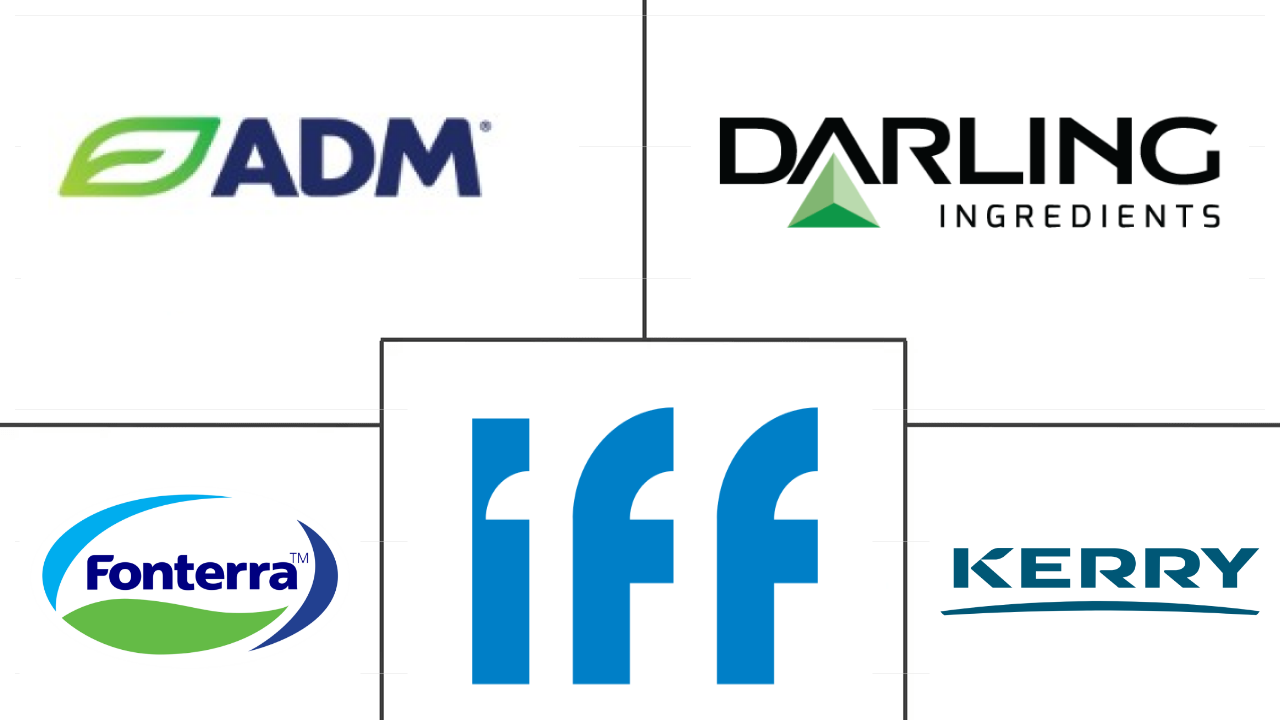Market Size of asia-pacific protein Industry
|
|
Study Period | 2017 - 2029 |
|
|
Market Size (2024) | USD 7.27 Billion |
|
|
Market Size (2029) | USD 9.59 Billion |
|
|
Largest Share by End User | Food and Beverages |
|
|
CAGR (2024 - 2029) | 5.69 % |
|
|
Largest Share by Country | China |
Major Players |
||

|
||
|
*Disclaimer: Major Players sorted in no particular order |
Asia-Pacific Protein Market Analysis
The Asia-Pacific Protein Market size is estimated at 7.27 billion USD in 2024, and is expected to reach 9.59 billion USD by 2029, growing at a CAGR of 5.69% during the forecast period (2024-2029).
7.27 Billion
Market Size in 2024 (USD)
9.59 Billion
Market Size in 2029 (USD)
5.27 %
CAGR (2017-2023)
5.69 %
CAGR (2024-2029)
Largest Market by Source
60.49 %
value share, Plant, 2023
Immense availability, functionality, vegan protein source, and low price of soy, wheat, and pea have contributed to the country's leading position of plant proteins.
Largest Market by End User
67.66 %
value share, Food and Beverages, 2023
F&B is driven mainly by the meat and beverage sectors. The multifunctionalities of plant protein imparted in these products, as well as rising consumers taste for vegan meals.
Fastest Growing Market by Source
5.96 %
Projected CAGR, Plant, 2024-2029
The surging demand for plant proteins, mainly pea and soy proteins, especially from beverages, snacks, bakery, and meat alternatives, aided in their fastest growth.
Fastest Growing Market by End User
7.58 %
Projected CAGR, Personal Care and Cosmetics, 2024-2029
Protein-enriched skin, body, and hair care products are on the rise. Players offering protein ingredients with distinct concentration as per the need is boosting the segment.
Leading Market Player
4.66 %
market share, Archer Daniels Midland Company, 2021

Archer Daniels Midland Company's leading position is attributed to its healthy snacking trend and its extensive product portfolio of proteins for food and animal nutrition.
Growing demand for animal-free products amid rising veganism is driving the food and beverages segment to grow resulting in the largest market share
- Food and beverage remained the largest protein-consuming sector in the region. Among others, bakery and dairy and meat alternatives remained the major application areas, capturing a 41% volume share of the protein consumed in the region in 2022. Growing demand for animal-free products amid rising veganism attracted greater integration of plants, especially soy proteins, in dairy and meat imitation applications.
- The sector was followed by animal feed that relied on plant proteins for their cost-effective and nutritional attributes. For example, in China, the total output of pork, beef, mutton, and poultry in 2021 was 88.87 million ton, up by 16.3% over the previous year. Asia-Pacific is one of the major cattle-producing regions with the dominance of countries like India and China, where the demand for quality-centric animal feed is growing, further benefitting the market studied. Soy protein is emerging as a high-quality feed ingredient for poultry, livestock, and aquaculture among retailers as it is highly digestible, making a good diet for cattle. Due to the significant share, the application is set to record a major CAGR of 6.02%, by volume, during the forecast period.
- The supplements hold a significant share in the proteins market, majorly sports nutrition sub-segment dominates the market, and it is projected to register a CAGR of 2.65% by value in the forecast period. One of the key elements supporting the growth of the protein market is the expanding popularity of fitness and sports culture, as well as the rising number of sports clubs and training facilities. In India, 54% of people frequently exercised in 2021, and 30% upgraded their fitness routines by utilizing cutting-edge applications and gadgets.
China leads the Asia-Pacific protein market, as a result of increasing demand for protein functionalities and awareness about protein-rich diets.
- By country, the market was led by China in 2022, majorly driven by the food and beverage sector. The demand for proteins in F&B is primarily driven by the increasing demand for protein functionalities and awareness about protein-rich diets. Moreover, in China, companies are making significant investments in rolling out innovative protein-based products in the retail space. For instance, Cargill, Hoafood, and Eat Just expanded their plant-based operations in China during the study period. China is also anticipated to register the fastest growth in the region, with a CAGR of 7.30% during the forecast period.
- The market was closely followed by India, which is being driven by the emerging young population and their demand for high-protein meals. Initiatives such as India Protein Score (IPS) are further boosting protein-related awareness among consumers. Launched in 2020 by LabelBlind and Right To Protein, the IPS highlights protein content in pre-packaged foods to help citizens who choose high-protein products. The immense availability, functionality, vegan protein source, and low price of soy, wheat, and pea have contributed to the country's leading position in plant proteins. Hence, the protein market in India is anticipated to register a CAGR of 5.81% by value during the forecast period.
- In Indonesia, plant-based fast food is becoming more popular, prompted by greater consumer awareness of health, sustainability, and animal welfare, with many food chains across the country adopting the vegan trend. Companies such as Starbucks, Ikea, and Burger King are launching vegan foods, which grows the demand for plant-based proteins in Indonesia. Hence, plant protein in Indonesia is projected to grow and register a CAGR of 3.35% by volume during the forecast period.
Asia-Pacific Protein Industry Segmentation
Animal, Microbial, Plant are covered as segments by Source. Animal Feed, Food and Beverages, Personal Care and Cosmetics, Supplements are covered as segments by End User. Australia, China, India, Indonesia, Japan, Malaysia, New Zealand, South Korea, Thailand, Vietnam are covered as segments by Country.
- Food and beverage remained the largest protein-consuming sector in the region. Among others, bakery and dairy and meat alternatives remained the major application areas, capturing a 41% volume share of the protein consumed in the region in 2022. Growing demand for animal-free products amid rising veganism attracted greater integration of plants, especially soy proteins, in dairy and meat imitation applications.
- The sector was followed by animal feed that relied on plant proteins for their cost-effective and nutritional attributes. For example, in China, the total output of pork, beef, mutton, and poultry in 2021 was 88.87 million ton, up by 16.3% over the previous year. Asia-Pacific is one of the major cattle-producing regions with the dominance of countries like India and China, where the demand for quality-centric animal feed is growing, further benefitting the market studied. Soy protein is emerging as a high-quality feed ingredient for poultry, livestock, and aquaculture among retailers as it is highly digestible, making a good diet for cattle. Due to the significant share, the application is set to record a major CAGR of 6.02%, by volume, during the forecast period.
- The supplements hold a significant share in the proteins market, majorly sports nutrition sub-segment dominates the market, and it is projected to register a CAGR of 2.65% by value in the forecast period. One of the key elements supporting the growth of the protein market is the expanding popularity of fitness and sports culture, as well as the rising number of sports clubs and training facilities. In India, 54% of people frequently exercised in 2021, and 30% upgraded their fitness routines by utilizing cutting-edge applications and gadgets.
| Source | ||||||||||||
| ||||||||||||
| ||||||||||||
|
| End User | |||||||||||||
| Animal Feed | |||||||||||||
| |||||||||||||
| Personal Care and Cosmetics | |||||||||||||
|
| Country | |
| Australia | |
| China | |
| India | |
| Indonesia | |
| Japan | |
| Malaysia | |
| New Zealand | |
| South Korea | |
| Thailand | |
| Vietnam | |
| Rest of Asia-Pacific |
Asia-Pacific Protein Market Size Summary
The Asia-Pacific protein market is experiencing significant growth, driven by the increasing demand for protein across various sectors, particularly in food and beverages. The region's market is characterized by a strong preference for plant-based proteins, such as soy, wheat, and pea, due to their functionality, vegan appeal, and cost-effectiveness. The bakery, dairy, and meat alternatives sectors are major consumers of protein, with a notable shift towards animal-free products amid rising veganism. This trend is further supported by the growing popularity of fitness and sports culture, which has bolstered the demand for protein supplements, especially in sports nutrition. Countries like China and India are at the forefront of this market expansion, with China leading in the food and beverage sector and India witnessing a surge in demand for high-protein meals among its young population.
The market landscape is fragmented, with key players like Archer Daniels Midland Company, Darling Ingredients Inc., and Fonterra Co-operative Group Limited playing significant roles. The animal feed sector is also a major contributor, leveraging plant proteins for their nutritional benefits. In addition, the market is seeing innovations and investments in protein-based products, particularly in China, where companies are expanding their plant-based operations. The demand for whey protein is notably high in Japan, driven by sports events and an aging population. Overall, the Asia-Pacific protein market is poised for continued growth, supported by evolving consumer preferences, technological advancements, and strategic investments in the region.
Asia-Pacific Protein Market Size - Table of Contents
-
1. MARKET SEGMENTATION (includes market size in Value in USD and Volume, Forecasts up to 2029 and analysis of growth prospects)
-
1.1 Source
-
1.1.1 Animal
-
1.1.1.1 By Protein Type
-
1.1.1.1.1 Casein and Caseinates
-
1.1.1.1.2 Collagen
-
1.1.1.1.3 Egg Protein
-
1.1.1.1.4 Gelatin
-
1.1.1.1.5 Insect Protein
-
1.1.1.1.6 Milk Protein
-
1.1.1.1.7 Whey Protein
-
1.1.1.1.8 Other Animal Protein
-
-
-
1.1.2 Microbial
-
1.1.2.1 By Protein Type
-
1.1.2.1.1 Algae Protein
-
1.1.2.1.2 Mycoprotein
-
-
-
1.1.3 Plant
-
1.1.3.1 By Protein Type
-
1.1.3.1.1 Hemp Protein
-
1.1.3.1.2 Pea Protein
-
1.1.3.1.3 Potato Protein
-
1.1.3.1.4 Rice Protein
-
1.1.3.1.5 Soy Protein
-
1.1.3.1.6 Wheat Protein
-
1.1.3.1.7 Other Plant Protein
-
-
-
-
1.2 End User
-
1.2.1 Animal Feed
-
1.2.2 Food and Beverages
-
1.2.2.1 By Sub End User
-
1.2.2.1.1 Bakery
-
1.2.2.1.2 Beverages
-
1.2.2.1.3 Breakfast Cereals
-
1.2.2.1.4 Condiments/Sauces
-
1.2.2.1.5 Confectionery
-
1.2.2.1.6 Dairy and Dairy Alternative Products
-
1.2.2.1.7 Meat/Poultry/Seafood and Meat Alternative Products
-
1.2.2.1.8 RTE/RTC Food Products
-
1.2.2.1.9 Snacks
-
-
-
1.2.3 Personal Care and Cosmetics
-
1.2.4 Supplements
-
1.2.4.1 By Sub End User
-
1.2.4.1.1 Baby Food and Infant Formula
-
1.2.4.1.2 Elderly Nutrition and Medical Nutrition
-
1.2.4.1.3 Sport/Performance Nutrition
-
-
-
-
1.3 Country
-
1.3.1 Australia
-
1.3.2 China
-
1.3.3 India
-
1.3.4 Indonesia
-
1.3.5 Japan
-
1.3.6 Malaysia
-
1.3.7 New Zealand
-
1.3.8 South Korea
-
1.3.9 Thailand
-
1.3.10 Vietnam
-
1.3.11 Rest of Asia-Pacific
-
-
Asia-Pacific Protein Market Size FAQs
How big is the Asia-Pacific Protein Market?
The Asia-Pacific Protein Market size is expected to reach USD 7.27 billion in 2024 and grow at a CAGR of 5.69% to reach USD 9.59 billion by 2029.
What is the current Asia-Pacific Protein Market size?
In 2024, the Asia-Pacific Protein Market size is expected to reach USD 7.27 billion.

